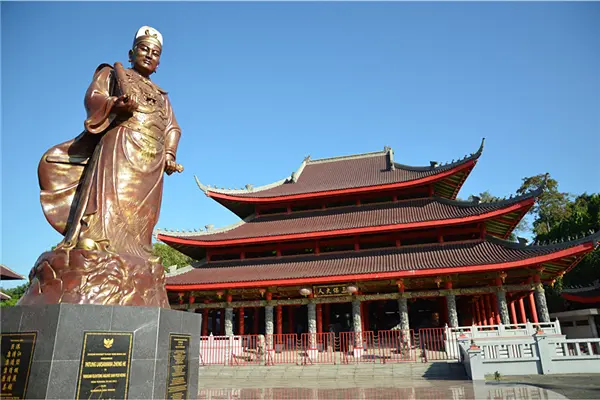Zheng He’s statue outside the Sam Poo-Kong main temple
As the largest country in the Southeast Asia region, Indonesia has a broad prospect for foreign investment. And Semarang, the capital and the largest city of the province of Central Java, which has a very deep historical links to China, has many kinds of industries to be cooperated with cities of China as Fuzhou, Hendrar Prihadi, the mayor of Semarang told Asia Pacific Daily in an exclusive interview.
“With a long history of maritime silk road with China, and under the leading of Presiden Joko Widodo which initiate to transform Indonesia into a global maritime fulcrum," he said, "it is a good momentum for us to playing a role in the maritime silk road.”
According to the statistics, Semarang city has a population around 1.5 million. Prihadi believed that it would benefit Semarang city to offer a competitive low cost of labor. “The characteristic of Semarang people which is calm and simple would make it an advantage for the investment in Semarang city”, he said.
Referring to the large number of local ethnic Chinese and Chinese nationals in Semarang city, Prihadi suggested that it's the best time for the Chinese in Semarang to make contributions in order to participate in the development of the Belt and Road initiative. He mentioned that the local ethnic Chinese have an organization of commerce which can support the government by developing many kind of industries in collaboration with the investor from Fuzhou.
Prihadi said that the city would dedicated to make it easier in the process of licensing to help the enterprises from Fujian or anywhere else in China to invest their money in Semarang city. He said: “we will try to make the climate conductive, safe and comfortable for investors from abroad.”
“Right now Indonesia is facing the ASEAN Economic Community where free trade is undeniable, " he said, "and so does the Belt and Road initiative.” Prihadi hoped that the cooperation between both cities will make benefits for the people of both cities.
Lying almost midway along the northern coast of Java, Semarang is a port city with a deep Chinese connection. Roughly a century before Columbus set sail to the Americas, Ming Dynasty China was outfitting the first of seven maritime expeditions to cross the Indian Ocean. Each of these expeditions involved the creation of colossal "treasure fleets" with up to 317 ships carrying almost 28,000 men. Zheng He, a Muslim eunuch who had proved his mettle in several military campaigns, would lead them all.
Zheng He arrived in Java when Islam was starting to make inroads into the Majapahit realm. The Malay Annals of Semarang and Cerbon, a controversial text that first came to light in the 1960s, suggests that the visits of the treasure fleet led to the foundation of Chinese Muslim communities throughout Indonesia, the Malay Peninsula and the Philippines.
On Java, Chinese Muslim leaders encouraged their followers to take on local names and adopt the Javanese way of life. Even today, the Javanese have not forgotten his role in helping to propagate Islam on what was then a predominantly Hindu-Buddhist island, a relatively new mosque in Surabaya – Indonesia’s second city – bears his name.
Of all the Javanese harbor towns the treasure fleet might have visited, none identifies with its admiral quite as much as Semarang. San Bao Long, the Chinese moniker for the city, is derived from Zheng He’s alternate name, Ma San Bao. According to the Malay Annals, the treasure fleet stopped there for a month in 1413 to undergo repairs, and Zheng He and his translator Ma Huan regularly visited the Chinese mosque for prayers.
(Asia Pacific Daily)
 简体中文
简体中文



